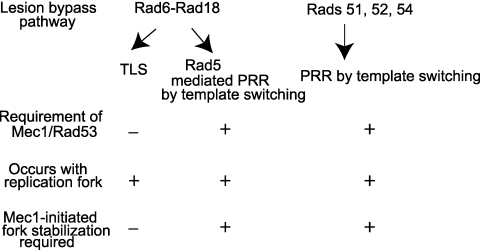FIG 6 .
Model for role of Mec1- and Rad53-mediated replication checkpoint in lesion bypass. It is proposed that lesion bypass by TLS or by template switching occurs in coordination with the replication fork and not in gaps that might have been left behind opposite from DNA lesions and then filled in later by these lesion bypass processes during the G2 phase. Since Mec1 and Rad53 are required for postreplication repair of UV-damaged DNA but TLS remains functional in the absence of these replication checkpoint proteins, we posit that both the Rad6-Rad18-Rad5-dependent and the Rad51-Rad52-Rad54-dependent template switching pathways require the Mec1/Rad53-mediated fork stabilization. From the observations that PCNA ubiquitylation is restricted primarily to S phase in UV-irradiated yeast cells (27) and that TLS remains functional in the absence of Mec1 and Rad53 (18), we infer that TLS occurs in coordination with the replication fork, but that does not necessitate the imposition of replication checkpoint. Presumably, TLS can occur in the absence of checkpoint, perhaps because of its being a less cumbersome and more efficient process than template switching.

